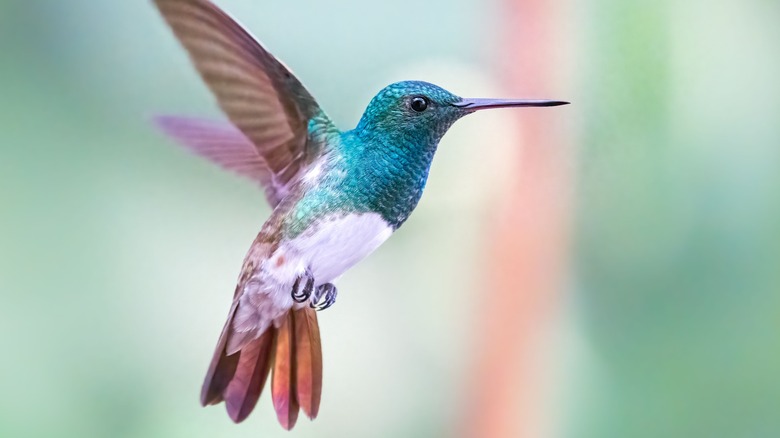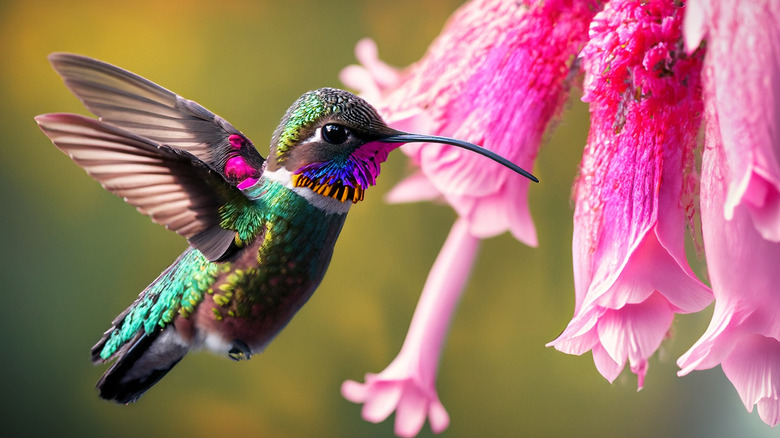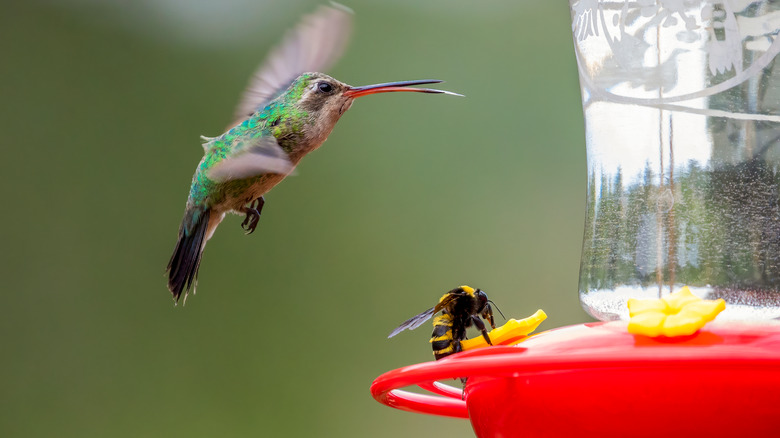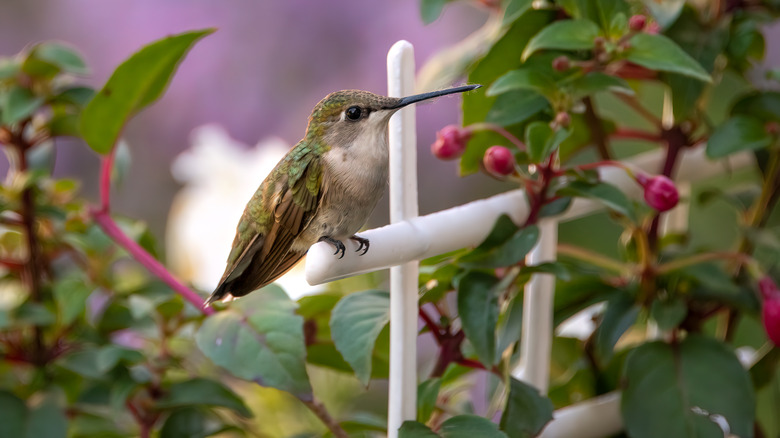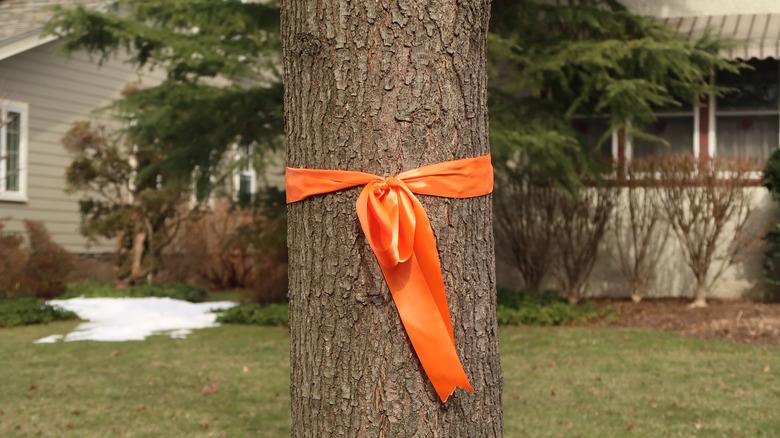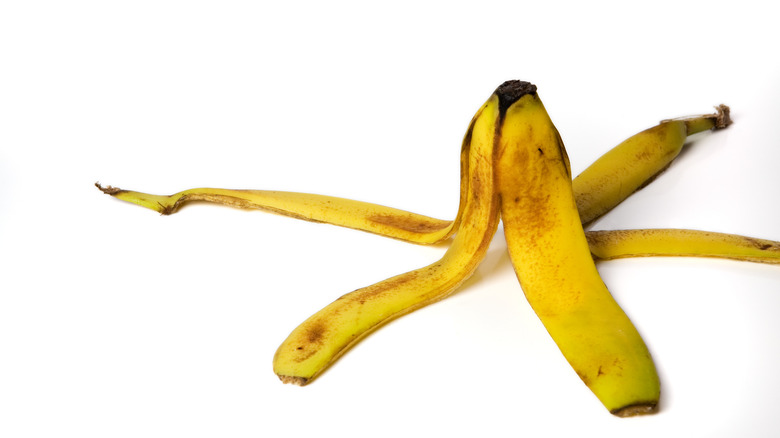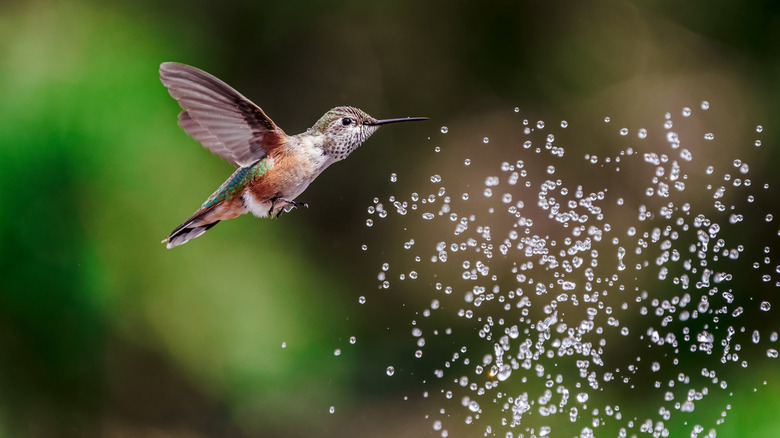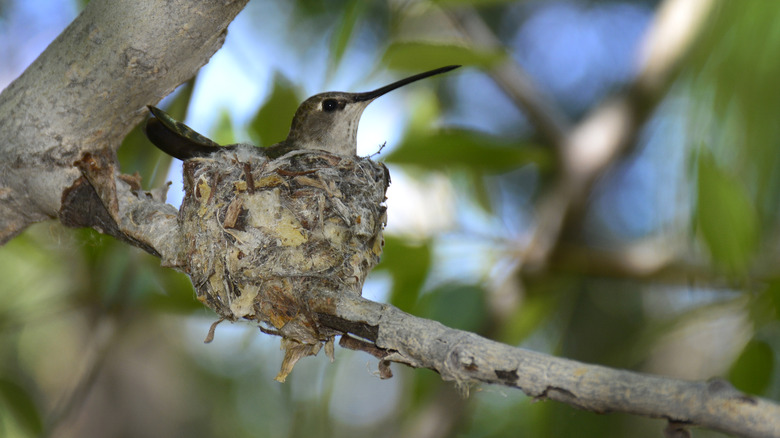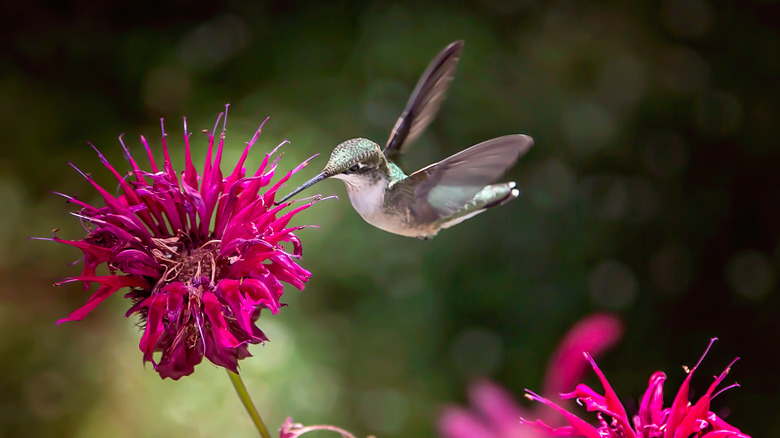8 Genius Tips And Tricks To Attract More Hummingbirds To Your Garden
Hummingbirds are perhaps one of the most popular birds in the U.S. These tiny, rapid-moving birds are not only cute to look at, but they're also important for the ecosystem due to their diet of flowering plants and insects. According to Cedar Hill Long House Native Art Prints, hummingbirds were also important to many indigenous cultures, who considered these birds symbols of love, joy, and intelligence.
The adoration for these birds is undeniable, and they can be found in most regions of the U.S. However, if you're not seeing these fascinating birds on a regular basis, you might be looking for ways to try to attract them to your garden. While hummingbirds appear to be attracted to certain flower colors, their needs go beyond aesthetics. When attracting these birds to your outdoor spaces, you need to consider their basic needs while also keeping them safe and healthy. This can involve the right food and feeding systems, drinking water hacks, plants, shelter, and more.
Plant hummingbird-friendly flowers
Perhaps one of the best ways to attract hummingbirds to your garden is to plant flowers they'll likely feed on. According to the Adirondack Council, hummingbirds visit an astonishing 1,000 to 2,000 flowers every single day, and they burn so many calories that they must eat a little bit every 10 to 15 minutes.
While you don't need to have thousands of flowers in your garden, hummingbirds can feed on the crucial nectar of the flowers you do provide for them. Still, not just any flowers will attract these birds to your garden, so it's important to make a list of plants that they favor so you can plan accordingly. Not only are hummingbirds attracted to begonias, but they also enjoy sages, bee balm, and tubular flowers like honeysuckle, according to the National Audubon Society. They also recommend using native plants whenever possible, as these are most likely to take well to the region you live in while becoming year-round assets to hummingbirds when they migrate or nest in your area.
Consider drawing hummingbirds with a feeder
Aside from planting certain flowers that may attract hummingbirds to your garden, you may also consider hanging a commercial hummingbird feeder. These are available in a variety of designs, and most often have flower-like openings for the birds to sip nectar out of. A hummingbird feeder also requires a little less maintenance over using flowers (although it certainly doesn't hurt to use both!).
There are two options you can use for food. First, you can make homemade hummingbird nectar with sugar and water. Ideally, you'll want to use granulated white sugar (not honey or artificial sugars) at a 1 to 4 ratio with hot water. If time is a concern, you can also use premade hummingbird food, but make sure these are free of red dyes that can inadvertently harm these birds. For the best results, invest in multiple feeders, as hummingbirds tend to be territorial and will fight each other over their food sources. Midwest Living recommends cleaning the feeders about every three days, or whenever you notice any cloudiness in the nectar. This can be done with a mixture of 1 to 4 parts vinegar and water.
Avoid using pesticides in your garden around hummingbirds
Commercial pesticides may keep certain insects and rodents away from your garden, but these can also be harmful to people and animals. If your main goal is to attract hummingbirds, know that pesticides can harm these small birds too. Another reason to avoid pesticide use is the fact that you'll likely find fewer insects if you have a lot of hummingbirds in your garden since these are a food source for them. Their need for insects is especially crucial around nesting season, when both adult and baby hummingbirds require a bit more protein.
The best way you can avoid accidental chemical harm to hummingbirds is by avoiding pesticide use altogether. If you have exceptional problems with pests, however, you may consider addressing the problem naturally so that any hummingbirds won't be harmed. For example, you can try planting peppermint as a way to help deter flies, spiders, and ticks to help keep these pests away while still encouraging hummingbirds to hang out in your garden.
Consider tying orange ribbons to your trees to attract hummingbirds
While hummingbirds are attracted to certain types of brightly colored flowers, they are also reportedly more likely to visit spaces that have other types of bright-colored items. For these reasons, tying orange ribbons on nearby trees can also attract these birds into your garden. As well as the bright colors, hummingbirds are also attracted to the way these ribbons can flash in the air when the wind picks up. This strategy may also be helpful in attracting the birds if you already have water and food out for them, but they are timid about visiting your garden.
Achieving this effect is relatively straightforward, and just involves tying a piece of ribbon long enough to wrap around the width of the tree while leaving enough on each side of the knot to blow in the wind so that hummingbirds can easily spot it. However, since not everyone has a tree in their yard, you can still create the same enticing effect for hummingbirds by tying the ribbons to feeders, or affixing them to nearby fencing, vines, or shrubs. You'll also want to check the ribbons regularly to make sure that pets or wildlife haven't chewed on the edges.
Place overripe banana peels in your garden to attract a valuable hummingbird food source
If anyone in your household eats bananas, consider holding on to the peels instead of disposing of them. Banana peels reportedly attract fruit flies, which subsequently attract hummingbirds, and the riper these are, the better. Overripe bananas could potentially bring even more of these birds into your yard. The addition of fruit flies to any other food sources you have, such as nectar, can also help balance out hummingbirds' diets during their visits. Aside from fruit flies, hummingbirds are also known to eat other insects, such as mosquitoes, gnats, aphids, and ants.
To try this hack, simply place banana peels near other sources of food, such as hummingbird feeders or flowers. The fruit flies alone may attract the birds, but they may also stick around when they see the other food sources your garden provides. Feel free to leave the peel out for several days as it naturally decomposes and eventually stops attracting new insects. Also, since it's not practical to leave banana peels in your house, you can place these in resealable plastic bags if you're not able to put them in your garden right after eating the bananas. Alternatively, you can place a basket of overripe fruit off the ground near your hummingbird feeders.
Offer hummingbirds a source of clean water
Nectar from flowers or hummingbird feeders aren't the only items that will draw hummingbirds to your garden. You'll also need to consider giving these tiny birds an opportunity to rehydrate by providing them with clean drinking water. This is especially important during nesting season, as well as on hot summer days. In fact, in the wild, hummingbirds are known to build nests near water sources, such as ponds, so they can grab a quick sip whenever they need it.
Before you set up a traditional birdbath though, know that hummingbirds prefer more shallow sources of water due to their small size. You can also hang a small waterer, which works similarly to a feeder, and suits their small size well. Alternatively, you might win over hummingbirds even more by installing water misters for them to fly through and take quick baths to help cool down while on the go. These may be attached directly to traditional birdbaths, so that way you can provide water for multiple bird species at once. Also, be sure to clean any birdbaths or waterers often so hummingbirds can depend on you for safe drinking water and visit your garden as often as possible.
Aside from food and water, be sure to offer hummingbirds shelter
Like other species, hummingbirds don't just need food and water for survival. They need shelter, too. In the wild, you're likely to see hummingbird nests on thin branches near tree trunks. They also prefer living and nesting near their food sources, such as wildflowers, or feeders with nectar that you provide for them.
Unlike other types of birds, hummingbirds don't take shelter in bird houses. Instead, you can help offer hummingbirds more indirect forms of shelter by making sure they have food and water, while also being able to count on your garden as a safe space free from pesticides and predators. You can also plant shrubs and small trees in your space to create hiding spots for hummingbirds to rest or nest. Just be sure these are near any flowers and feeders you have for them. Also, keep in mind that these can take time to grow into larger spaces hummingbirds might feel comfortable inhabiting.
Keep pets out of areas where hummingbirds might hang out
If you've tried all the items on this list and still aren't attracting hummingbirds, you might consider whether other animals might be scaring them off. According to the International Hummingbird Society, cats are the most common predators of hummingbirds, including both domesticated and feral cats that may be roaming your neighborhood.
The Society also recommends hanging hummingbird feeders five feet off the ground or higher to help deter cats. Also, if you have a cat, it's best to keep them indoors and away from areas where birds might land. Dogs, on the other hand, may not necessarily prey on hummingbirds, but they can still deter them from hanging out in your garden. While it can be difficult to manage predators out of your control, such as hawks, frogs, and even large insects like praying mantises, you can possibly help by monitoring your garden for signs of these creatures and keeping all hummingbird food and water sources clean.
Additionally, it's important to be wary of spider webs. While hummingbirds can sometimes accidentally get stuck, they also need spider silk as part of their nesting materials, so you shouldn't necessarily clear your garden of all spider webs you find. If you do spot a hummingbird caught in a web, consider contacting a local wildlife rehabilitator for help or, in worst-case scenarios, remove the bird yourself and allow them to recover in a box or carrier for up to 15 minutes.

